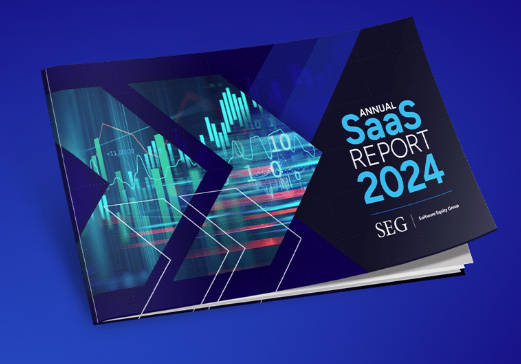Software Equity Group’s annual report is in, revealing that SaaS is here to stay.
As the report details, many in the technology industry, the story of 2023 was all about artificial intelligence, its rapidly advancing commercial applications, and the speed and extent with which it will impact the world we live in, both from a business and personal perspective.
4 SaaS components of 2023 that will impact what we see in 2024.
1. The advancement of generative AI and its impact on software and SaaS companies, both as users and creators of AI, was a top story in 2023 and one that will be front and center in 2024 as well.
However, quietly and perhaps a bit behind the scenes, another storyline proved to be just as important in 2023: the resilience of the U.S. economy and subsequent cementing of software and SaaS’s place as a key pillar driving digital transformation globally.
2. Inflation decreased by nearly half (with the CPI dropping from 6.5% in December 2022 to 3.4% in 2023), interest rates stabilized, and the labor market remained strong (unemployment rate a 3.7% with 216k jobs added in December).
3. Software and SaaS companies pivoted towards operational efficiency, and fortunately for the U.S. economy, many of these companies were successful in this endeavor. The result was a fantastic year for the SEG SaaS IndexTM, with the Index increasing 34% YOY, outpacing the S&P 500 and Dow Jones, and trailing only the Nasdaq (43% increase) among major indices.
On the M&A side, there were over 2,000 SaaS transactions, making 2023 the second strongest year on record for SaaS M&A, only narrowly trailing 2022.
4. While AI garnered a lot of the hype in 2023, an equally important story is the strength and resilience of the software ecosystem. 2023 was another proof point that SaaS is “here to stay.”
4 Macroeconomic Outlooks for 2024: Inflation, interest rates, employment, growth and politics
1. Inflation continues to decrease, finishing 2023 at 3.4% YOY compared to December 2022. The underlying core CPI, which strips out volatile food and energy prices, measured 3.9% in December 2023, its lowest YOY change since May 2021. Though additional cooling is still needed for inflation to reach the 2% annual target the Federal Reserve sets, the progress made in 2023 is encouraging.
2. The prospect of the Federal Reserve cutting interest rates is coming into focus. They will closely watch inflation and the unemployment rate (which remains solid at 3.7%) as it plots the course through this year.
The timing of potential cuts will greatly impact publicly traded SaaS stocks and the M&A markets, as the potential for a lower-cost borrowing environment would be a welcome sight to these markets.
3. What about a recession? 2023 growth is now expected to come in between 2 and 3%.
GDP growth is expected to decline slightly in 2024 but remains positive at around 2%. This scenario avoids a recession altogether and supports a healthy economic environment.
A scenario in which the U.S. beats GDP estimates again provides an upside case for publicly traded SaaS stocks in 2024. This possibility is further bolstered by the recently released Q4 GDP data, in which the U.S. GDP grew 3.3%, beating consensus estimates.
4. The economy will be a primary focus on the 2024 campaign trail. However, the reality remains that the Federal Reserve dictates monetary policy independent of political election cycles.
Election risk is still present due to the divisive nature of the current U.S. political environment,
albeit much less discussed than during the last cycle.
Globally, geopolitical risks include regional conflicts in the Middle East and their impact on oil prices, the ongoing Russia-Ukraine war, and tensions between China and Taiwan.
To read the details of Software Equity Group’s 2024 SaaS Report, click here.

